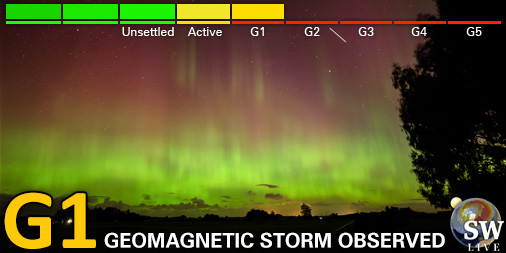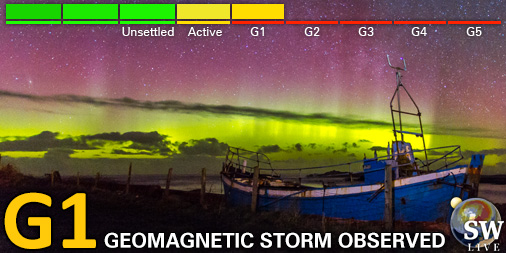Het archief bekijken van vrijdag 20 juni 2003
Activiteitenrapport
Bij elke genoemde zonnevlam in dit rapport werd een schaalfactor toegepast door het Space Weather Prediction Center (SWPC). Vanwege de SWPC-schaalfactor worden zonnevlammen 42% kleiner gerapporteerd dan voor de wetenschappelijke data. De schaalfactor werd verwijderd uit onze gearchiveerde zonnevlamdata om de werkelijke fysieke eenheden weer te geven.
Rapport van de zonne- en geofysische activiteit van 2003 Jun 20 2200 UTCOpgemaakt door de NOAA © SWPC en verwerkt door Poollicht.be
USAF/NOAA rapport van de zonneactiviteit en geofysische activiteit
SDF Nummer 171 gepubliceerd omstreeks 2200Z op 20 Jun 2003IA. Analyse van de actieve zonneregio's en zonneactiviteit van 19-2100Z tot 20-2100Z
Solar activity increased to low levels today. Region
386 (S07E17) produced two low levels C-class flares today along with
several B-class flares. The northern portion of the penumbral field
appears to have undergone some rotation since yesterday while the
delta magnetic structure in the southern leading edge of group has
changed little during the period and remains intact. Region 387
(N18E36) was quiescent today although spot coverage and magnetic
complexity have both shown growth over the period. Region 389
(S12E14) was newly numbered today.
IB. Voorspelling zonneactiviteit
Solar activity is expected to range
from low to moderate levels. Region 386 remains capable of
producing an isolated major event.
IIA. Samenvatting geofysische activiteit 19-2100Z tot 20-2100Z
The geomagnetic field was at predominantly unsettled levels today as
effects from the western most recurrent coronal hole wanes. The
greater than 2 MeV electron flux at geosynchronous orbit reached
high levels today.
IIB. Voorspelling geofysische activiteit
The geomagnetic field is
expected to be at predominantly unsettled levels. Active conditions
may exist especially at high latitudes beginning late on day two
with the return of a recurrent coronal hole high speed stream.
III. Kans zonnevlammen van 21 Jun tot 23 Jun
| Klasse M | 40% | 40% | 40% |
| Klasse X | 10% | 10% | 10% |
| Proton | 10% | 10% | 10% |
| PCAF | yellow | ||
IV. Penticton 10.7 cm Flux
Geobserveerd 20 Jun 117 Voorspeld 21 Jun-23 Jun 115/115/120 90 dagen gemiddelde 20 Jun 125
V. Geomagnetische A index
Geobserveerd Afr/Ap 19 Jun 016/018 Geraamd Afr/Ap 20 Jun 010/015 Voorspeld Afr/Ap 21 Jun-23 Jun 010/015-012/015-012/020
VI. Kansen op geomagnetische activiteit van 21 Jun tot 23 Jun
| A. Gemiddelde breedtegraad | |||
|---|---|---|---|
| Actief | 15% | 25% | 25% |
| Kleine storm | 05% | 05% | 10% |
| Zware-ernstige stormcondities | 01% | 01% | 01% |
| B. Hoge breedtegraad | |||
|---|---|---|---|
| Actief | 30% | 30% | 40% |
| Kleine storm | 15% | 15% | 20% |
| Zware-ernstige stormcondities | 05% | 05% | 05% |
Alle tijden in UTC
<< Keer terug naar de dagelijkse overview pagina
Op basis van de huidige parameters is er nu geen kans op poollicht in België en Nederland
Laatste nieuws
Laatste forumberichten
Suggesties? 8Noorderlicht kans 6-1-2025 2Poollicht 1 januari 2025 2Naar Noorwegen in Maart? 3Noorderlicht kans 10/11-10-2024 56
Meer forumberichtenSteun Poollicht.be!
Om ook bereikbaar te blijven bij grote poollichtkansen hebben we een zware server nodig die alle bezoekers aankan. Doneer en steun dit project zodat we online blijven en je geen enkele poollichtkans mist!

Laatste alerts
15:09 UTC - Hemisferisch vermogen
Het OVATION-model voorspelt dat het hemisferisch vermogen 50GW zal bereiken om 15:48 UTC
08:00 UTC - Geomagnetische activiteit
G1 - Kleine geomagnetische storm (Kp5) Drempel bereikt: 07:52 UTC
zaterdag 3 mei 2025
10:45 UTC - Geomagnetische activiteit
G1 - Kleine geomagnetische storm (Kp5) Drempel bereikt: 10:30 UTC
08:57 UTC - Hemisferisch vermogen
Het OVATION-model voorspelt dat het hemisferisch vermogen 76GW zal bereiken om 09:32 UTC
01:00 UTC - Geomagnetische activiteit
G1 - Kleine geomagnetische storm (Kp5) Drempel bereikt: 00:55 UTC
Ruimteweer feitjes
| Laatste X-klasse uitbarsting | 28/03/2025 | X1.1 |
| Laatste M-klasse uitbarsting | 30/04/2025 | M2.03 |
| Laatste geomagnetische storm | 03/05/2025 | Kp5 (G1) |
| Zonnevlekkenloze dagen | |
|---|---|
| Laatste zonnevlekkenloze dag | 08/06/2022 |
| Maandelijks gemiddeld zonnevlekkengetal | |
|---|---|
| april 2025 | 140.6 +6.4 |
| mei 2025 | 58 -82.6 |
| Afgelopen 30 dagen | 114 -17.5 |





